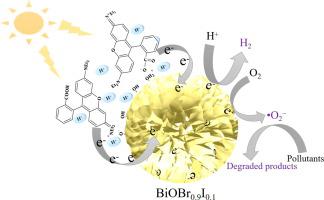Journal of Colloid and Interface Science ( IF 9.4 ) Pub Date : 2020-07-08 , DOI: 10.1016/j.jcis.2020.07.014 Liping Han 1 , Yuewei Lv 1 , Bo Li 1 , Hao Wen 1 , Hongwei Huang 2 , Yuxi Guo 1 , Zhan Lin 1

|
Sensitization with a dye has great potential for dealing with the photoexcited charge recombination problem for photocatalysts. One of the main factors affecting the dye-sensitization performance is the absorption capacity of semiconductor for dye. Specific surface area of semiconductors and pH values of reaction system are critical for the absorption capacity. Herein, we firstly developed a BiOBr0.9I0.1 solid solution via a facile and fast sacrificial template method. The prepared BiOBr0.9I0.1 has distinct advantages, e.g. loose and rich porous structure, more oxygen vacancies (OVs), and a large specific surface area, which result in strong adsorption for dye molecules. Sensitized by Rhodamine B (RhB), the prepared BiOBr0.9I0.1 photocatalyst shows remarkably improved high activity for H2 evolution, which is 27.9 times than that of the dense structured BiOBr0.9I0.1 under a direct photocatalytic process. By lowing the pH of RhB solution, the absorption ability is further improved because of the protonation of dye. At low pH, the prepared BiOBr0.9I0.1 can efficiently activate the molecular oxygen to produce superoxide radicals (O2−), resulting a super high dye-sensitized degradation activity for tetracycline hydrochloride (TCH) and methyl orange (MO) pollutants, outperforming most catalysts reported under similar conditions by the direct photocatalytic reaction. The present method represents a new direction in the development of dye-sensitization nanomaterials with good performance for energy and environment applications.
中文翻译:

在可见光下通过染料敏化的BiOBr0.9I0.1增强H2的释放和分子氧的活化。
用染料敏化具有巨大潜力,可以解决光催化剂的光激发电荷重组问题。影响染料敏化性能的主要因素之一是半导体对染料的吸收能力。半导体的比表面积和反应体系的pH值对于吸收能力至关重要。本文中,我们首先通过一种简便而快速的牺牲模板法开发了BiOBr 0.9 I 0.1固溶体。制备的BiOBr 0.9 I 0.1具有明显的优势,例如疏松和丰富的多孔结构,更多的氧空位(OVs)和较大的比表面积,这导致染料分子的强吸附性。由若丹明B(RhB)敏化制备的BiOBr0.9 I 0.1光催化剂显示出显着改善的H 2释放高活性,是在直接光催化过程中致密结构化的BiOBr 0.9 I 0.1的27.9倍。通过降低RhB溶液的pH值,由于染料的质子化,吸收能力进一步提高。在低pH下,所制备的BiOBr 0.9我0.1可以有效地激活的分子氧,以产生超氧自由基(Ò 2 -),对四环素盐酸盐(TCH)和甲基橙(MO)污染物具有超高的染料敏化降解活性,在类似条件下通过直接光催化反应,其性能优于大多数催化剂。本方法代表了在具有良好的能源和环境应用性能的染料敏化纳米材料发展的新方向。


















































 京公网安备 11010802027423号
京公网安备 11010802027423号